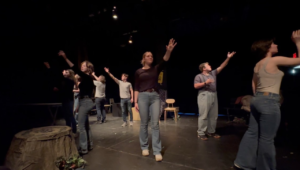A Spotlight on Tracy Chapman

Image courtesy of Rhino.com
By Caroline Morris
In the late 1980s, the Golden Age of hip-hop was thriving. Names like LL Cool J, Public Enemy, Queen Latifah, and Salt-n-Pepa still live on in the public memory. But there was another artist who dominated the charts during this period, who history has in many ways left behind.
Tracy Chapman exploded onto the music scene fresh out of college in 1988 with her self-titled album, Tracy Chapman. The record was adored by the public, reaching the Number 1 spot on the Billboard 200 Chart and remaining on the list for 61 weeks.
But Chapman was not a hip-hop artist or a rapper: she was a folksy singer-songwriter. This choice of genre may seem inconsequential looking back after thirty years, but Chapman’s decision to write bluesy music is a symbol of her bravery and individuality.
The Golden Age of hip-hop that was dominating the music industry for Black Americans during the late 80s and early 90s was much more than just a trend. It was a cultural movement, tied up in the Black neo-nationalist movement of the time. Rap was the vehicle in which Black Americans cried out against social injustices and sought allies in the “war against the black man.”
Chapman, as a black woman with incredible musical gifts, would have been expected to envelop herself in this movement as a hip hop artist. Despite her desire for social change and experience with injustice leveled against Black people in America, she created her music in a style that contrasted against the expectation for a Black artist.
Tracy Chapman is filled with many of the same messages as the hip-hop songs of the day, that call out the reality of racism and injustice in America. Growing up in a Black neighborhood in Cleveland, Chapman witnessed first hand the unjust realities of life as a Black American and brought these progessive themes into her music.
In her song “Across the Lines,” Chapman depicts in no uncertain terms the tensions that existed between the different races in America. She sings, “Little black girl gets assaulted/Ain’t no reason why/Newspaper prints the story/And racist tempers fly/Next day it starts a riot.”
These words bring to life a horrific image of the violence leveled against Black people in America and the “c’est la vie” attitude that lets it continue unimpeded.
Chapman also addresses the rampant poverty that affects Black neighborhoods and families that seems inescapable in her song “Talkin’ Bout A Revolution.”
“While they’re standing in the welfare lines/Crying at the doorsteps of those armies of salvation,” sings Chapman.
Once again, Chapman pulls from her witness to poverty in her Cleveland childhood to paint a heartbreaking picture of the suffering of Black people as they cry out for salvation. It is not a call to war but a call to mercy, to help these people who she has seen denied the necessities of life.
Her song “Behind the Wall” deals with the issues of domestic violence and the police.
“The police always come late/If they come at all/And when they arrive/They say they can’t interfere/With domestic affairs/Between a man and his wife,” Chapman sings.
This song, done in haunting a capella, addresses the reality of Black Americans: that the police do not truly protect them. When they are called, they may not come. But it also speaks specifically to the plight of Black women.
During this time period, even the most influential and progressive Black female figures were meant to follow the lead of Black men and be subordinate to them. But Chapman again broke from the expectations of the cultural standard and addressed the inescapable reality of domestic abuse that many Black women suffered.
Chapman is a master at incorporating these themes of social reform into her music in a way that seeks understanding. This endeavor was aided by her genre choice, because while the movement for rap and hip-hop was important and inspirational in its own right, it appealed to and was designed for a Black audience.
A folksy, blues style, however, was quintessentially and nostalgically American, and by making the choice not to follow the lead of her Black musical contemporaries, Chapman could reach a wider audience with her message.
In a Rolling Stone article about Chapman, one of her concerts is described: “a cross section of fans that vividly illustrates how broad her appeal can be.”
Tracy Chapman broke barriers, stood as an individual, and did not let others define or control her. She achieved wild success with her first album, and yet she is no longer one of the names that lives on in memory or on playlists like those from the Golden Age do.
But she should.
Chapman crafted beautiful music with inspirational messages about social change that remain pertinent today. Black Americans still suffer from police brutality, racism, and increased poverty rates, and 40% of Black women experience domestic violence at one point in their lives. The issues she brings to light through her music sadly live on, and still require social change.
Tracy Chapman’s name may have faded into history as time moved forward, but her music remains beautifully moving and socially pertinent. So it is time to give Chapman her due and honor the bravery, skill, individuality, and justice she stood for through her music, and finally listen to what she has been telling us.







